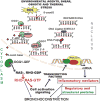Pathophysiology of bronchoconstriction: role of oxidatively damaged DNA repair
- PMID: 26694039
- PMCID: PMC4940044
- DOI: 10.1097/ACI.0000000000000232
Pathophysiology of bronchoconstriction: role of oxidatively damaged DNA repair
Abstract
Purpose of review: To provide an overview on the present understanding of roles of oxidative DNA damage repair in cell signaling underlying bronchoconstriction common to, but not restricted to various forms of asthma and chronic obstructive pulmonary disease.
Recent findings: Bronchoconstriction is a tightening of smooth muscle surrounding the bronchi and bronchioles with consequent wheezing and shortness of breath. Key stimuli include air pollutants, viral infections, allergens, thermal and osmotic changes, and shear stress of mucosal epithelium, triggering a wide range of cellular, vascular, and neural events. Although activation of nerve fibers, the role of G-proteins, protein kinases and Ca++, and molecular interaction within contracting filaments of muscle are well defined, the overarching mechanisms by which a wide range of stimuli initiate these events are not fully understood. Many, if not all, stimuli increase levels of reactive oxygen species, which are signaling and oxidatively modifying macromolecules, including DNA. The primary reactive oxygen species target in DNA is guanine, and 8-oxoguanine is one of the most abundant base lesions. It is repaired by 8-oxoguanine DNA glycosylase1 during base excision repair processes. The product, free 8-oxo-7,8-dihydro-2'-deoxyguanosine base, is bound by 8-oxoguanine DNA glycosylase1 with high affinity, and the complex then functions as an activator of small guanosine triphosphatases, triggering pathways for inducing gene expression and contraction of intracellular filaments in mast and smooth muscle cells.
Summary: Oxidative DNA damage repair-mediated cell activation signaling result in gene expression that 'primes' the mucosal epithelium and submucosal tissues to generate mediators of airway smooth muscle contractions.
Conflict of interest statement
The authors declare that they have no competing interests.
Figures



Similar articles
-
The Potential Role of 8-Oxoguanine DNA Glycosylase-Driven DNA Base Excision Repair in Exercise-Induced Asthma.Mediators Inflamm. 2016;2016:3762561. doi: 10.1155/2016/3762561. Epub 2016 Jul 25. Mediators Inflamm. 2016. PMID: 27524866 Free PMC article. Review.
-
Molecular mechanisms underlying airway smooth muscle contraction and proliferation: implications for asthma.Respir Med. 2008 Aug;102(8):1173-81. doi: 10.1016/j.rmed.2008.02.020. Epub 2008 Jun 24. Respir Med. 2008. PMID: 18579364 Review.
-
Mechanisms of immune sensitization of human bronchus.Am J Respir Crit Care Med. 1998 Nov;158(5 Pt 3):S161-70. doi: 10.1164/ajrccm.158.supplement_2.13tac130. Am J Respir Crit Care Med. 1998. PMID: 9817740 Review.
-
Expression of human oxoguanine glycosylase 1 or formamidopyrimidine glycosylase in human embryonic kidney 293 cells exacerbates methylmercury toxicity in vitro.Toxicol Appl Pharmacol. 2013 Aug 15;271(1):41-8. doi: 10.1016/j.taap.2013.04.008. Epub 2013 Apr 19. Toxicol Appl Pharmacol. 2013. PMID: 23607987
-
8-Oxoguanine DNA glycosylase-1-driven DNA base excision repair: role in asthma pathogenesis.Curr Opin Allergy Clin Immunol. 2015 Feb;15(1):89-97. doi: 10.1097/ACI.0000000000000135. Curr Opin Allergy Clin Immunol. 2015. PMID: 25486379 Free PMC article. Review.
Cited by
-
The Correlation of PM2.5 Exposure with Acute Attack and Steroid Sensitivity in Asthma.Biomed Res Int. 2022 Aug 18;2022:2756147. doi: 10.1155/2022/2756147. eCollection 2022. Biomed Res Int. 2022. Retraction in: Biomed Res Int. 2024 Jan 9;2024:9891074. doi: 10.1155/2024/9891074. PMID: 36033576 Free PMC article. Retracted. Review.
-
miR-155 Modulates Cockroach Allergen- and Oxidative Stress-Induced Cyclooxygenase-2 in Asthma.J Immunol. 2018 Aug 1;201(3):916-929. doi: 10.4049/jimmunol.1701167. Epub 2018 Jul 2. J Immunol. 2018. PMID: 29967100 Free PMC article.
-
Pollen-induced oxidative DNA damage response regulates miRNAs controlling allergic inflammation.Am J Physiol Lung Cell Mol Physiol. 2017 Dec 1;313(6):L1058-L1068. doi: 10.1152/ajplung.00141.2017. Epub 2017 Aug 10. Am J Physiol Lung Cell Mol Physiol. 2017. PMID: 28798252 Free PMC article.
-
OGG1-DNA interactions facilitate NF-κB binding to DNA targets.Sci Rep. 2017 Mar 7;7:43297. doi: 10.1038/srep43297. Sci Rep. 2017. PMID: 28266569 Free PMC article.
-
Oxidative stress in asthma pathogenesis: mechanistic insights and implications for airway smooth muscle dysfunction.Cell Tissue Res. 2025 Apr;400(1):17-34. doi: 10.1007/s00441-025-03953-7. Epub 2025 Feb 7. Cell Tissue Res. 2025. PMID: 39918765 Review.
References
-
- Pelaia G, Maselli R, Matera MG. Treatment of chronic obstructive pulmonary disease by dual bronchodilation with coformulation of indacaterol/glycopyrronium. Pharmacology. 2014;94:249–258. Dr. Pelaia and his colleagues review molecular mechanism(s) involved in pathophysiology of airway smooth muscle contraction and discuss the pharmacological basis of bronchodilation. - PubMed
-
- Rundell KW, Anderson SD, Sue-Chu M, et al. Air quality and temperature effects on exercise-induced bronchoconstriction. Compr Physiol. 2015;5:579–610. - PubMed
-
- Randolph C. An update on exercise-induced bronchoconstriction with and without asthma. Curr Allergy Asthma Rep. 2009;9:433–438. - PubMed
-
- Koskela HO, Purokivi MK, Nieminen RM, Moilanen E. Asthmatic cough and airway oxidative stress. Respir Physiol Neurobiol. 2012;181:346–350. - PubMed
-
- Koskela HO. Cold air-provoked respiratory symptoms: the mechanisms and management. Int J Circumpolar Health. 2007;66:91–100. - PubMed
Publication types
MeSH terms
Grants and funding
LinkOut - more resources
Full Text Sources
Other Literature Sources
Molecular Biology Databases
Research Materials

